If you want to manage or change Critical, Low, and Reserve battery notification action and level in Windows 11/10, here is what you will have to do. You can manage battery notification settings using the Local Group Policy Editor and Registry Editor.
Let’s assume that the Control Panel or Windows Settings is not opening on your computer. At such times, you can change the Low, Reserve, and Critical battery level and action of your Windows 10 laptop using the Local Group Policy Editor or Registry Editor.
Change Low, Reserve, Critical battery notification level & action
To change Low, Reserve, and Critical battery notification level and action using Group Policy, follow these steps-
- Press Win+R to open the Run prompt.
- Type gpedit.msc and hit the Enter button.
- Go to Notification Settings in Computer Configuration.
- Double-click on various settings on the right-hand side.
- Select the Enabled option and choose a battery level.
- Click Apply and OK to save the change.
Open the Local Group Policy Editor on your computer. For that, press Win+R, type gpedit.msc, and hit the Enter button. After that, navigate to this path-
Computer Configuration > Administrative Templates > System > Power Management > Notification Settings
In the Notification Settings, you will see some settings on the right-hand side. Let’s categorize these settings into two different sections – notification action and notification level.
Notification action related settings will help you set the action you want to perform when your laptop reaches the point. Notification level related settings will let you choose a battery percentage or level you want to set to perform the “notification action.”
- Low battery notification level: If you want to bypass the 10% battery level for the “Low battery” notification level, this setting is for you.
- Low battery notification action: Change the low battery notification action to Sleep or Shut down.
- Critical battery notification level: Choose a percentage that you want to set as the critical level. The default one is 5%.
- Critical battery notification action: It helps you choose an action you want to perform when your laptop reaches the notification level as set by you.
- Reserve battery notification level: You can set a reserve battery notification level from here. It will bypass the default 7% settings.
To set a battery notification level, double-click on the corresponding setting, select the Enabled option and type a battery level in percentage.
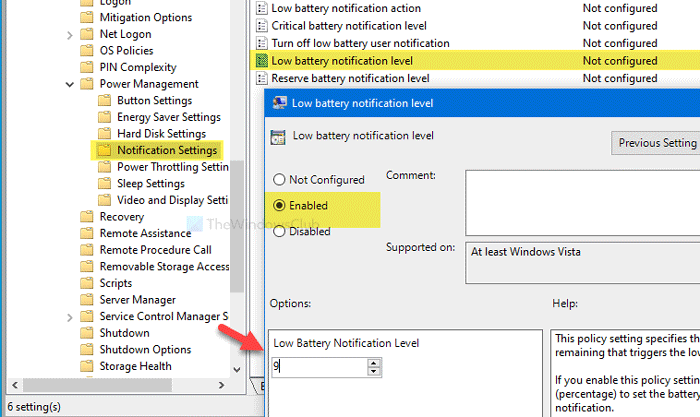
At last, click the Apply and OK buttons to save the change.
Similarly, if you want to change action, double-click on a particular setting, select the Enabled option and choose an action from the drop-down list.
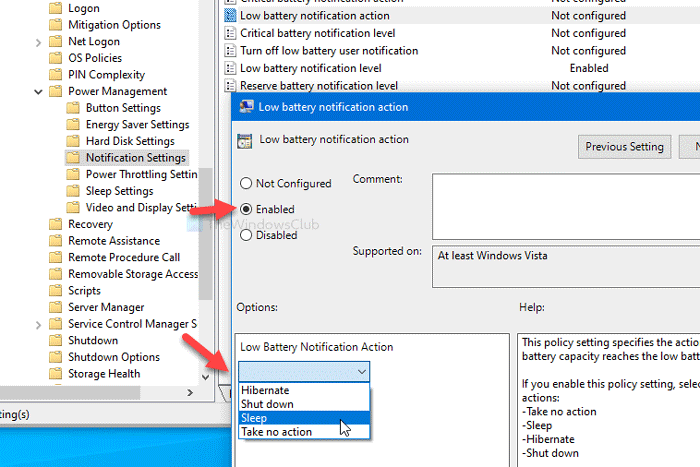
To save the change, click on Apply and OK buttons, respectively.
There is another setting available here – Turn off low battery user notification. it lets you disable the low battery notification. To do that, double-click on it, select the Enabled option, and click the Apply and OK.
Read: Laptop battery not charging after BIOS update
Manage Low, Reserve, and Critical battery notification level and action
To change Low, Reserve, and Critical battery notification level and action using Registry Editor, follow these steps-
- Press Win+R.
- Type regedit and hit the Enter button.
- Click Yes in the UAC prompt.
- Go to Power Settings in HKLM key.
- Right-click on it > New > Key.
- Name it as mentioned below.
- Right-click on this Key > New > DWORD (32-bit) Value.
- Name it as DCSettingIndex.
- Double-click on it to set the Value data.
- Click OK to save the change.
Let’s check out these steps in detail.
At first, you will have to open the Registry Editor. For that, press Win+R, type regedit, hit the Enter button, and click the Yes button in the UAC window. After that, navigate to the following path-
HKEY_LOCAL_MACHINE\SOFTWARE\Policies\Microsoft\Power\PowerSettings
If you cannot find Power or PowerSettings, right-click on Microsoft > New > Key and name it as Power. Following that, right-click on Power > New > Key, and call it PowerSettings.
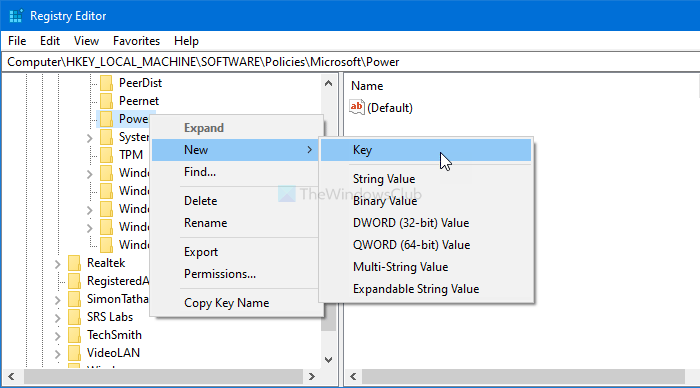
Then, you will have to create some sub-keys and REG_DWORD values in the PowerSettings key. To create a sub-key, right-click on PowerSettings > New > Key, and name it as mentioned below-
- Low battery notification level: 8183ba9a-e910-48da-8769-14ae6dc1170a
- Low battery notification action: d8742dcb-3e6a-4b3c-b3fe-374623cdcf06
- Critical battery notification level: 9A66D8D7-4FF7-4EF9-B5A2-5A326CA2A469
- Critical battery notification action: 637EA02F-BBCB-4015-8E2C-A1C7B9C0B546
- Reserve battery notification level: F3C5027D-CD16-4930-AA6B-90DB844A8F00
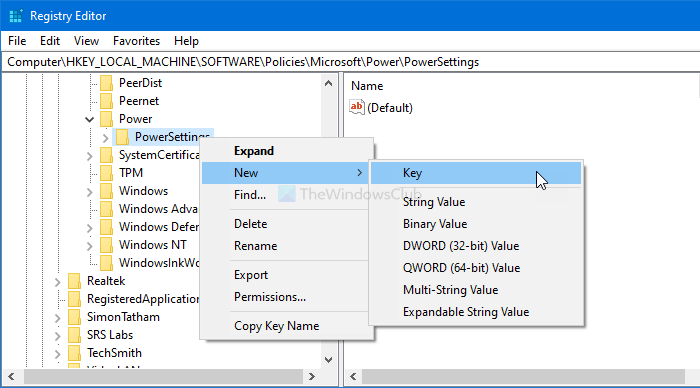
After that, if you want to create a REG_DWORD value, right-click on a key > New > DWORD (32-bit) Value and name it as DCSettingIndex.
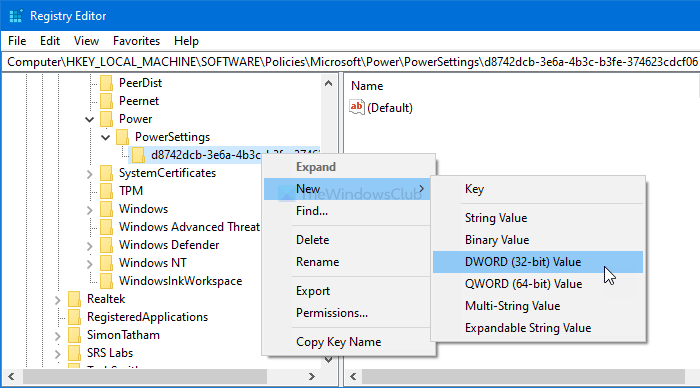
If you create a key to set the notification level, you will have to enter a percentage value (e.g., 8 or 10).

Similarly, if you want to create a notification action, you will have to enter a value as follows-
- Take no action: 0
- Sleep: 1
- Hibernate: 2
- Shut down: 3
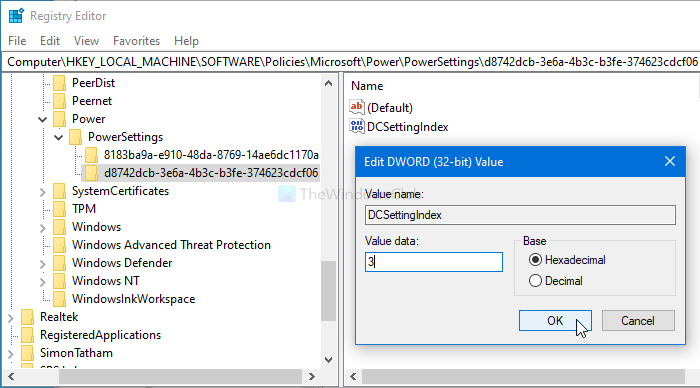
To set the Value data of any DWORD (32-bit) Value, double-click on it, enter the value as mentioned above, and click the OK button to save the change.
That’s all!
Read: Disable PC isn’t charging or Slow charger warnings in Windows
How do you turn the battery saver on or off on your Windows laptop?
Right-click the battery icon and move the slide from power saver to performance mode. However, remember that this will speed up battery usage, and your laptop will power off earlier than expected.
Why does my laptop turn off suddenly when there’s plenty of battery life?
It usually happens when your battery has aged, and Windows cannot show it correctly. While you get to see if the laptop will last, it may turn off suddenly because the capacity has dropped.
Leave a Reply